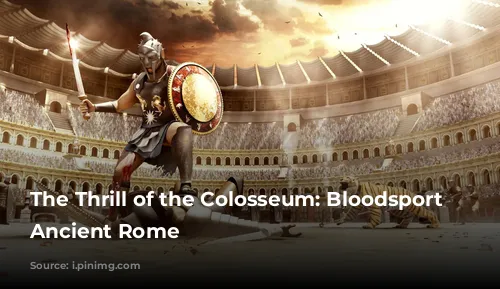Imagine a scene: two men, hardened and fierce, stand poised in the center of a massive arena. The air crackles with anticipation as thousands of Roman citizens roar with excitement. These are gladiators, men who risk their lives for the spectacle of combat.
The gladiators circle each other, each move calculated, each glance a silent threat. Their goal is not to swiftly kill but to maim and trap their opponent, drawing out the fight to satisfy the bloodthirsty crowd. The clash of swords and maces echoes through the arena as the gladiators dance a deadly ballet, sweat and sand swirling in the hot Roman sun. Suddenly, one gladiator throws a net, ensnaring his opponent. The crowd gasps as he raises his trident, poised to strike. The fate of the defeated gladiator hangs in the balance. Will the crowd, impressed by his valor, cry out for mercy, granting him a reprieve from death? Or will their dissatisfaction seal his fate?
From Sacrifice to Spectacle
This gladiatorial spectacle, a symbol of the brutality of Roman entertainment, has its roots in ancient Etruscan traditions. The Etruscans, who lived in northern Italy, held public games called ludi, featuring gladiator battles and chariot races, as offerings to their gods. The Romans, adopting this custom, turned the ludi into elaborate affairs, holding them ten to twelve times a year. These games, funded by the emperor, served a dual purpose: to entertain the masses, particularly the poor and unemployed, and to distract them from their hardships, preventing potential uprisings.
A Feast for the Senses
As time passed, the Roman games became increasingly extravagant and elaborate. Emperors, vying for the favor of the people, outdid their predecessors, staging ever-more spectacular events. The games expanded, featuring more participants, more frequent occurrences, and escalating costs.
The Coliseum: A Monument to Entertainment
The heart of the gladiatorial contests was the Coliseum, a colossal stadium that opened its doors in 80 C.E. Located in the heart of Rome, this architectural marvel boasted three levels of arches, reaching the height of a modern 12-story building. Its massive capacity, 50,000 spectators, mirrored the city’s thirst for entertainment.
Inside the Coliseum, a labyrinth of rooms, hallways, and cages housed the gladiators, animals, and weapons, awaiting their turn to perform. The arena floor, a stage for life-or-death battles, could even be flooded, transforming the Coliseum into a spectacular venue for naval battles. However, these aquatic spectacles were rare, as the water’s destructive potential posed a threat to the Coliseum’s structure.
The Men Behind the Masks
The gladiators, the stars of the show, often came from the ranks of slaves, criminals, or prisoners of war. Some, however, fought for a chance at freedom. Criminals sentenced to death found themselves thrust into the arena, unarmed and defenseless. Yet, surprisingly, some people, even women, volunteered for this perilous path, risking their lives for the promise of fame and glory. These brave souls trained rigorously, honing their skills in specialized schools, preparing for the deadly dance.
A Brutal Ballet
The games were not limited to man-against-man contests. The arena also witnessed ferocious clashes between animals, from bears and rhinos to tigers, elephants, and giraffes, driven by hunger and instinct. These venationes, or wild beast hunts, sometimes pitted gladiators against these fearsome creatures, adding an element of unpredictable danger to the spectacle. In rare instances, these creatures were unleashed upon helpless victims, tied to stakes and left to the mercy of their savage instincts.
Chariot Races: A Race Against Time
The Romans also had a passion for chariot racing, held in circuses, dedicated arenas designed for this thrilling event. The most renowned of these was the Circus Maximus, a colossal structure in Rome. Chariots, pulled by teams of two or four horses, raced over seven laps, covering distances of three to five miles.
The games also included other equestrian events, echoing modern thoroughbred horseracing. In one type of race, riders started on horseback but later dismounted, continuing the race on foot, adding an element of unpredictable strategy to the competition.
A Society Obsessed with Bread and Circuses
As the Roman Empire began its decline, the poet Juvenal poignantly captured the sentiment of the populace with his famous observation: “The people are only anxious for two things: bread and circuses.” This statement reveals the deep-seated need for the masses to be fed and entertained, highlighting the role of the games in providing a temporary escape from the harsh realities of daily life.
The gladiatorial games of ancient Rome stand as a stark reminder of the brutality and spectacle that characterized Roman society. These events, rooted in ancient rituals, evolved into elaborate, extravagant spectacles, reflecting the Roman obsession with entertainment and their willingness to overlook the human cost of this bloody spectacle.
